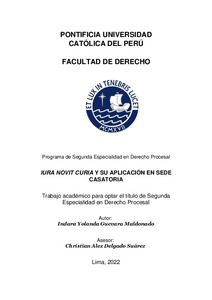| dc.contributor.advisor | Delgado Suárez, Christian Alex | |
| dc.contributor.author | Guevara Maldonado, Indara Yolanda | |
| dc.date.accessioned | 2023-05-26T18:12:11Z | |
| dc.date.available | 2023-05-26T18:12:11Z | |
| dc.date.created | 2022 | |
| dc.date.issued | 2023-05-26 | |
| dc.identifier.uri | http://hdl.handle.net/20.500.12404/25040 | |
| dc.description.abstract | La Corte Suprema es un órgano de vértice que considero trascendental y central
en la administración de justicia de nuestro país por dos razones: la primera,
porque es el órgano máximo en el que se definen las controversias de manera
definitiva; y, segundo, porque tiene atribuciones que resultan fundamentales
para el desarrollo y la construcción del derecho. Una de esas atribuciones es
precisamente la que motivó la elaboración del presente trabajo: la aplicación del
principio iura novit curia en sede casatoria. Para ello, he dividido el artículo en 3
partes: la primera, enfocada en los momentos en los que la Corte Suprema aplica
el principio iura novit curia; la segunda, enfocada en los criterios para su
aplicación; y, la tercera, centrada en los límites para su aplicación.
Todo lo anterior, partiendo desde las hipótesis específicas de que la Corte
Suprema sí aplica dicho principio, sí determina los momentos de su aplicación,
sí establece criterios y sí fija límites, las cuales- han sido rebatidas o confirmadas
en las conclusiones. En efecto, luego del análisis del problema y el desarrollo del
presente trabajo, pude concluir que la Corte Suprema sí aplica el principio iura
novit curia, sin embargo, no determina los momentos de su aplicación, no
establece criterios ni mucho menos fija límites. | es_ES |
| dc.description.abstract | The Supreme Court is an apex body that I consider transcendental and central in
the administration of justice in our country for two reasons: first, because it is the
highest body in which disputes are defined; and second, because it has powers
that are fundamental for the development and construction of law. One of these
powers is precisely the one that motivated the preparation of this paper: the
application of the iura novit curia mainly in cassation proceedings. For this
purpose, I split the article into 3 parts: the first one, focused on the moments in
which the Supreme Court applies the main iura novit curia; the second, focused on the criteria for its application; and the third, focused on the limits for its
application.
It is for all the above, starting from the specific hypothesis that the Supreme Court
does apply said mainly, does determine the moments of its application, does
establish criteria and does set limits, which have been refuted or confirmed in the
conclusions. In effect, after the analysis of the problem and the development of
this work, I was able to conclude that the Supreme Court does apply the main
iura novit curia, however, it does not determine the moments of its application, it
does not establish criteria, much less set limits. | es_ES |
| dc.description.uri | Trabajo académico | es_ES |
| dc.language.iso | spa | es_ES |
| dc.publisher | Pontificia Universidad Católica del Perú | es_ES |
| dc.rights | info:eu-repo/semantics/closedAccess | es_ES |
| dc.subject | Proceso judicial--Perú | es_ES |
| dc.subject | Recurso de casación--Legislación--Perú | es_ES |
| dc.subject | Perú. Corte Suprema de Justicia | es_ES |
| dc.title | Iura Novit Curia y su aplicación en sede | es_ES |
| dc.type | info:eu-repo/semantics/bachelorThesis | es_ES |
| thesis.degree.name | Segunda Especialidad en Derecho Procesal | es_ES |
| thesis.degree.level | Título Profesional | es_ES |
| thesis.degree.grantor | Pontificia Universidad Católica del Perú. Facultad de Derecho | es_ES |
| thesis.degree.discipline | Derecho Procesal | es_ES |
| renati.advisor.dni | 43234974 | |
| renati.advisor.orcid | https://orcid.org/0000-0001-5629-8609 | es_ES |
| renati.author.dni | 46288138 | |
| renati.discipline | 421109 | es_ES |
| renati.level | https://purl.org/pe-repo/renati/level#tituloSegundaEspecialidad | es_ES |
| renati.type | https://purl.org/pe-repo/renati/type#trabajoAcademico | es_ES |
| dc.publisher.country | PE | es_ES |
| dc.subject.ocde | https://purl.org/pe-repo/ocde/ford#5.05.01 | es_ES |






